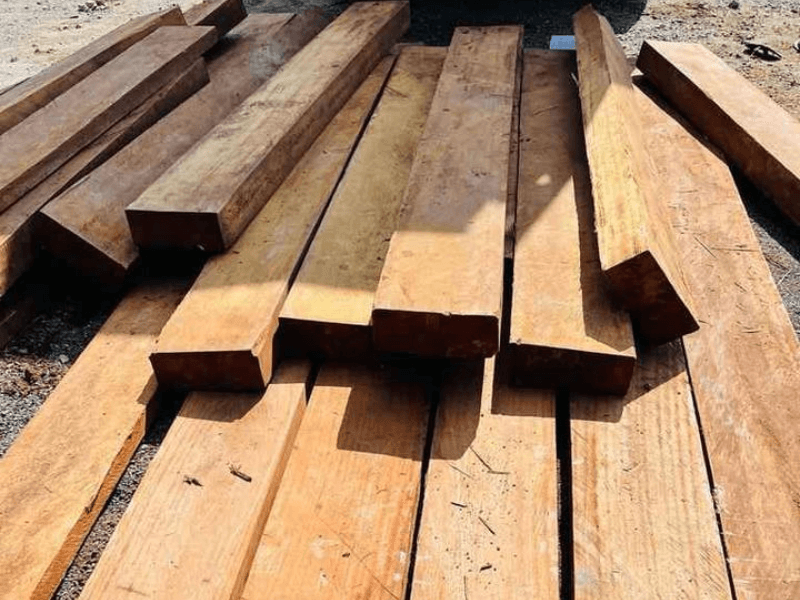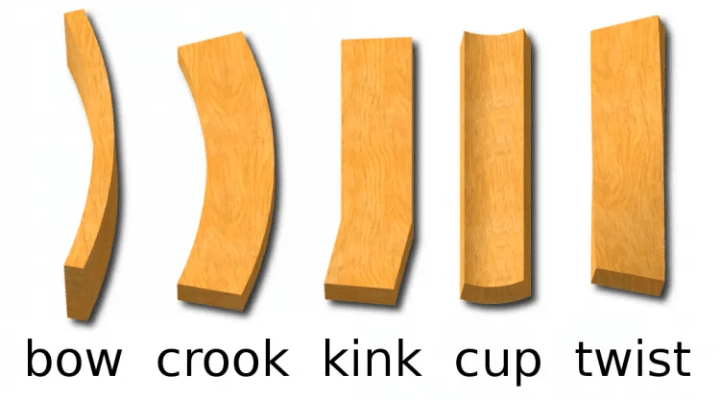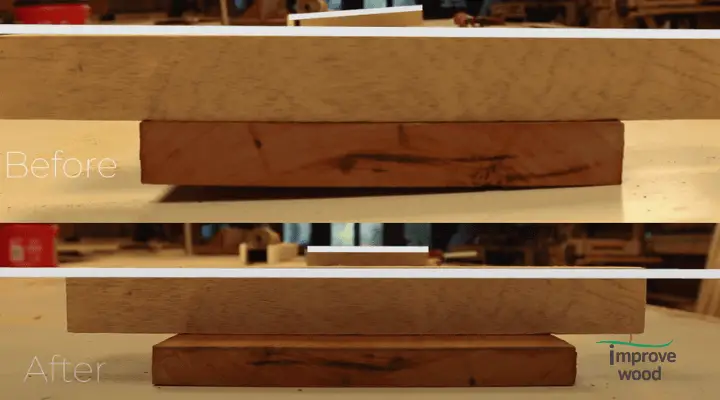Can warped wood be straightened? This is an age-old question that comes up frequently in the construction and remodeling industries, as well as with woodworkers who want to reclaim wood from their scrap piles. The answer is yes, you can straighten it, but it’s a little more complicated than one might expect. Here are some tips and tricks on how to unwarp wood properly so your piece can be used as efficiently as possible.
How to Unwarp Wood
Using heat
It is one of the easiest and most common ways used in fixing wood warp. Even though it is not that easy to unwrap a piece of wood into its original shape, the use of heat has always been considered an efficient remedy for unwarping minor wood warp cases. For you to achieve incredible results by using the heating method, you should follow the following steps.
- Lay the warped board on a flat surface.
- Heat the board by applying extra pressure to the damaged places until it becomes very hot, but do not overheat it to avoid wood damage.
- Bend the warped wood carefully and allow it to cool to return to its original shape.
Ironing
Using an iron to rectify wood warping, you will need a flat iron and two moist towels. You should also follow the procedure below to get accurate results.
- Squeeze all the excess water from the towel and ensure that it isn’t dripping.
- Wrap the board in moistened towels ensuring that the affected area is covered.
- Place the covered board on an iron board or a flat surface, ensuring the concave surface faces downwards.
- In the case of steam iron, heat the iron to its maximum point until it becomes very hot.
- Press the hot iron on the wood surfaces starting from the warped ones. Repeat the process several times, applying pressure all over the board for better results.
- Remove the cover on the wood surface and allow it to dry for an extended period.
Use of Sunlight
Just like heat, sunlight is another suitable method of unwarping wood. In this method, direct rays from the sun heat the board, helping it absorb moisture from the towels.

The steps followed in the methods are,
- Wet two or more towels with water and later squeeze the water out of the towel.
- Cover the moistened towels around the warped wood.
- Place the covered wood on a flat surface.
- Make sure that the covered board is in direct sunlight, and its concave side should face downwards.
- Leave the warped wood to dry for several days and spray it with additional water to keep it moist.
- Keep checking on the wood daily and when you are satisfied that it is unwarped, remove the towel around it and dry the wood thoroughly.
- If you do not see any changes in a couple of days, you are advised to try another method.
Applying Pressure on the wood surfaces
The use of Pressure to get rid of wood warping is considered to be one of the best methods.
Shown below are the steps on what to do.
- Place a steaming towel that has been drained or paper towels on the concave side of the board.
- Apply moisture to the warped area of the wood and ensure all of it has been absorbed.
- Tightly wrap several layers of plastic on the wood over the paper towels to reduce evaporation and keep the wood moist for an extended period.
- Place the wood on a press and tighten it to unwarp the warped areas.
- Place your wood in a warm area for several days. After that, you have to check on it regularly to ensure it is not being damaged.
- After a while, unwarp the wood and leave it to dry.
- Check on the wood to see if the warp disappeared or not. If it did not varnish, you have to apply more pressure to the wood and leave it in a clamping position for a longer period.
Use of Winding sticks
It is one of the easiest wood straightening methods.
In the use of winding sticks to rectify a wood warp, the following steps are followed.
- Place the warped board on a flat surface using winding sticks.
- Determine the type of wood warp you are dealing with for easier working.
- Straighten the board using the winding sticks depending on the type of warping.
- Repeat the above process for accurate results.
Using a Combination of a Moist piece of Cloth, Nylon paper, and Pressure
As uneven moisture causes the wood to bend or twist, the same method is used to turn a piece of wood into its original shape instantly. For the method to be efficient, there are several measures to be followed.
- Cover the warped board with a moistened cloth.
- Wrap the covered wood with nylon paper nicely.
- Collect stones or bricks that will be used to apply pressure on the warped board.
- Carefully place the bricks or stone on the covered wood surfaces and leave it for some time.
Fixing the ends of the Wood plates
The method is suitable for unwarping small wooden objects. It is considered the most accessible method as it only requires nails, pliers, and a hammer. The nails are used to fix the ends of the warped board, and the pliers are used to remove the nails.
To attain excellent results from the above methods of straightening warped wood, you must follow all the steps carefully. But before that, you can still prevent your wood from warping as it helps you avoid the unnecessary process of fixing it. There are several ways of preventing wood warping, and they include.
Factors That Cause Wood to Warp
Unfavourable Weather Conditions
When the wood comes into contact with moisture or humidity, there is a higher possibility that warping will occur. This is because it tends to shrink when it comes in contact with moisture, while cracks when exposed to high temperatures.
Poor Wood Quality
Though wood species do not matter a lot as all woods are pruned to twisting and warping. You must be very careful while choosing the type of wood for your furniture. The types of wood species used in woodworking include,
- Pine
- Spruce
- Redwood
- Mahogany
- Cherry
- Oak
- Fir
Some of the woods are More robust to warp due to their hardness, while others easily warp due to their softness.
Mismanagement of wood
To prevent a piece of wood from warping, You should put it under proper care. Some companies dealing with wood products always Pressure-treat the wood and stick it in green lumber to prevent uneven wetting and drying. However, various types of wood products are pruned to warping, and hence any light movement can lead to warping.
Destruction From Insects
The leading cause of wood warping is insect attack. Some insects such as termites, carpenter bees, and ants feed on the wood causing much damage to wood structures. To get rid of the wood-boring insects, Kiln drying is used.
Wood Thickness
In most cases, wood warping can be caused by the thickness of the wood. This is because thick wood pieces take a longer time to absorb moisture than thin ones. Therefore it is advisable to use a sizable piece of wood with very straight grain, making it less likely to warp.
To unwrap a piece of wood, you have to ensure that your wood objects or products are warped. Shown below are the steps used to check on wood warping.
How to Know if your Wood is Warped
- Place your piece of wood on a flat surface.
- Measure along the edges of the wood to ensure that they are equal.
- Confirm if there is any part of your wood raised above the other parts. If there is a raised part, then your wood is warped.
To fix wood warping condition, you should know that there are different types of wood warp, and they include:
Types of Wood Warp

1.Bow warping
It most likely occurs in longboards. In bowing, the fibers on the top side of the board dry faster as they are exposed to air. This causes the fibers on the lower side to dry slowly, making them contract both ends, forming an archer’s bow shape.
2.Crook warping
Just like bow warping, crook warping occurs along the wood’s edge. It makes a straight board look like a curved road.
3.Kink warping
It occurs along the lumber’s width. Kink warping mainly appears on softwood where there is a knot or grain distortion.
4. Cupping
A type of wood warping that makes aboard has a “U” shape from one end to the other. It makes the board useless for construction and woodwork if not unwarped. The best way of checking cup warping is by laying the wood on a flat surface and carefully looking at both sides of the wood to ensure it does not have a “U” shape.
5. Twist warping
It is frequently caused by spiral or diagonal grain on the wood surface. Spiral grain is always present in the wood, while diagonal grain develops due to sawing crooked wood along its surface rather than its bark.
Though wood warping has become one of the significant problems recently experienced in wood industries, there are many ways of reducing or fixing wood warping, just as shown below.
Ways of Preventing Wood Warping
Proper Storage
You have to store your wood in a clean, calm, and dry place to prevent it from warping. Proper storage helps the wood not to absorb large amounts of moisture from its surrounding. In addition, you should ensure that your wood lies on a flat surface, in uniform thickness, and you should avoid placing heavy loads on your wood to prevent cupping.
Properly Drying and Curing your Wood
Before you store your wood in a clean and safe place, you have to ensure that you dry it out for it to release moisture. In this case, a kiln is often used to control the drying process. It helps the wood to dry evenly, minimizing any drying defects associated with rapid and uneven drying.
But you should note that excess usage of the kiln on wood surfaces may lead to some wood defects if not properly analyzed. This happens when the moisture difference between the outer shell of the wood and the core is too great. In such cases, you can reverse the process to correct the deformity.
Having a proper wood inspection
To be sure about your wood’s safety, you have to monitor the moisture content of your wood products and that of their storage and production areas. Then, for best results, choose non-warped boards with straight grain.
Grain Orientation
As wood warping can ruin both the practical and aesthetic value of the wood, You have to check on your grain patterns. Grain patterns influence the way wood works; hence some woods, especially those cut from the heart of a tree, are more resistant to shrinking and warping.
Avoid Juvenile Wood
It is cut from the pith of a tree in its early stages. The wood has a high rate of shrinkage, and it is always unstable. It causes mature wood to contract and deform, having either bowed or crooked type of warping.
Safety Tips to be Taken while Fixing a Warped Wood
While working on a wood warp, you should take some measures to ensure that you are protected from heavy items and excess heat used during woodwork. The measures include,
- Wear heat-resistant protective gloves to prevent you from burning your hands while using the iron.
- Place the wood on a solid surface while using the pressure method to prevent it from breaking.
- Use the proper safety equipment while working to avoid body cuts and other body injuries.
- Use the right tool while working on getting accurate results
- Disconnect power while changing the blade orbits of your power tools to reduce malfunction and electric accidents.
- Use sharp blade orbits for cleaner cuts as blunt tools can be dangerous to use to kick back.
- Cut against the motion of the wood.
- If you want to remove wood waste or cut-offs, wait until a spinning blade has stopped its movement to prevent injuries.
- Minimize distractions in your work area to ensure you use the least time
Final thoughts on how to unwarp wood
Although wood warping is a natural process for every wood species, it can be tiresome to eliminate the problem. Sometimes, it is even difficult to find a long-lasting solution to the problem if it is not prevented early. But using suitable methods and correct steps to rectify the condition always helps you get rid of the wood warp and maintain the natural beauty of your wood products. You should also follow the safety rules mentioned above to ensure that you are protected from injuries and body cuts.
Lay the warped board on a flat surface. 2. Heat the board by applying extra pressure to the damaged places until it becomes very hot but do not overheat it to avoid wood damage. 3. Bend the warped wood carefully and allow it to cool to return to its original shape.

